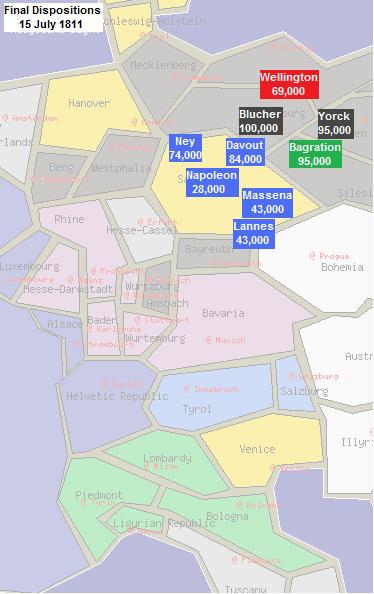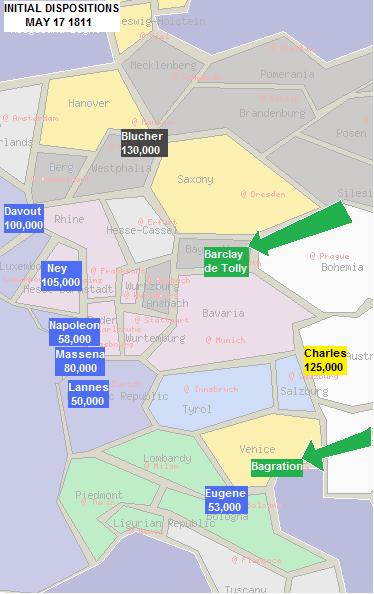
THE WAR OF THE SIXTH COALITION
Germany - May 17th - July15th 1811

The war of the fifth coalition in 1810 had seen Austria lose the provinces of Tyrol and Salzburg to France and also the formation of the Confederation of the Rhine. This new organization of German states meant that minor duchies and princedoms had something to aspire to beyond being Prussian or Austrian satellites. It is not clear if it was Prussia's outrage at this new German entity or Napoleon's desire to add new states to the Confederation, but in the spring of 1811, a new coalition was formed by Britain to renew the fight against the French. For the first time, the Prussians would join the alliance.
The coalition would include Britain, Prussia, Russia, Austria, Saxony, Hanover, Venice, and Denmark.
France could count on the Confederation of the Rhine, but also had the Tyrol and Salzburg among their allied nations. The northern Italian states were also pro-French.
Hesse-Cassel, Netherlands, Tuscany, and the Papal States would seek to remain neutral.
COALITION PLAN
The alliance did not have a supreme commander at the start of the war and each nation deployed with their own interests at heart. The Russians wanted to conquer French provinces in Italy and Central Germany but also, due to Russia missing the fight in the war of 1810, they appeared determined to get stuck in. It would take them a week or more to get their armies assembled at the front. The Prussians under Blucher were looking at straightforward fights in Berg and Westphalia, trusting the Russians to protect Prussia's southernmost provinces. Charles and the Austrians were focussed on continuing the last war and deployed to fight to retake Salzburg and Tyrolia.
Fairly large portions of the coalition armies would be made up of conscripts.
THE FRENCH PLAN
Napoleon wanted to experiment with the battalion
carre concept. This is a system where the various wings of the army form
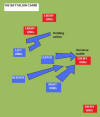 a
moving square with all elements staying within 1-2 days of one another. The
center of the square would have the wing commanders, all keeping in close
contact and communication. As the battalion carre advanced, it would have the
ability to react quickly to gathered intelligence and mass multiple wings
against a single point with alarming speed. The formation would require close
control from Imperial headquarters and would limit the range that the Grand
Armee could roam, but the theory was that the French goal would be to destroy
opposing armies rather than conquering far-flung provinces.
a
moving square with all elements staying within 1-2 days of one another. The
center of the square would have the wing commanders, all keeping in close
contact and communication. As the battalion carre advanced, it would have the
ability to react quickly to gathered intelligence and mass multiple wings
against a single point with alarming speed. The formation would require close
control from Imperial headquarters and would limit the range that the Grand
Armee could roam, but the theory was that the French goal would be to destroy
opposing armies rather than conquering far-flung provinces.
The French though could not entirely abandon their vast empire. Eugene was given a small command in northern Italy and Marshal Lannes was given the task of confronting any Austrian aggression into the Alps.
PRE-WAR MOVEMENTS
The opposing armies were mobilizing from 17 May. The French advanced to the borders and the Russians began to build up their forward armies. Blucher's Prussians marched west from Magdeburg.
21 MAY - WAR IS DECLARED
With the invasion of Tuscany and Hesse-Cassel, the French initiated the war and brought these minor nations into the coalition against them. Charles crossed the border into Salzburg on the same day.
On the 23rd of May, an undefended Salzburg was conquered by the Austrians. Eugene in Italy had sent a flying column through the Apennines to seize Tuscany and then they were to move on to Rome. Eugene's main force was going to try to stay mobile and keep the Russians delayed at the many river lines in northern Italy.
On the 24th of May, Eugene would be stunned by news that the Russians had landed a force behind his river line defences, at Rimini. His position had been turned! On the same day, Ansbach fell to the French. It was becoming clear that a massive French invasion was pushing through the center and toward Saxony.
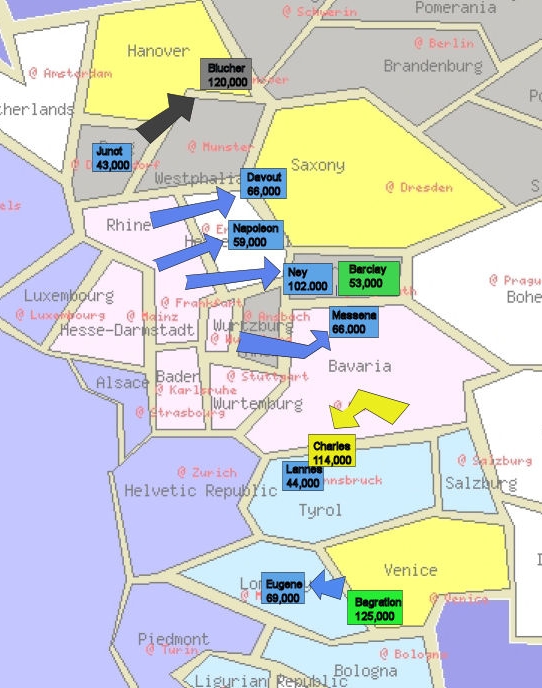 The
advance elements of Blucher, mostly Landwher, made contact with the French
around Dusseldorf and had the whole of Davout's wing
descend upon them. The resulting reverse, and news that the main French thrust
was pushing toward Saxony, would discourage Blucher from engaging Davout
further and he would turn his army about and order it to march back to their
depot at Magdeburg.
The
advance elements of Blucher, mostly Landwher, made contact with the French
around Dusseldorf and had the whole of Davout's wing
descend upon them. The resulting reverse, and news that the main French thrust
was pushing toward Saxony, would discourage Blucher from engaging Davout
further and he would turn his army about and order it to march back to their
depot at Magdeburg.
By the 25th of May, only four days after war was declared, the Austrians were in Munich. The French flying column crossed the border into the Papal States but they had been too diluted by Eugene and would find themselves repulsed by hastily raised Papal divisions.
The French Battalion Carre was far too strung out
for Napoleon's liking and he ordered it to reform before advancing further. Davout had been slowed down by Blucher's tentative probes and Massena
was too far ahead and to the east. He had already begun to make contact with the
mustering Russian armies of Barclay de Tolly at Bayreuth. Because Davout had
lost contact with Blucher, it was decided that the direction of advance of the
battalion carre would continue east, hoping to concentrate against the Russians.
further. Davout had been slowed down by Blucher's tentative probes and Massena
was too far ahead and to the east. He had already begun to make contact with the
mustering Russian armies of Barclay de Tolly at Bayreuth. Because Davout had
lost contact with Blucher, it was decided that the direction of advance of the
battalion carre would continue east, hoping to concentrate against the Russians.
Archduke Charles, having made his initial conquests of Bavaria and Salzburg, turned southwest and began to march his whole force against Innsbruck. In Italy, Bagration is making gains against Eugene's small force. On the 31st of May, Bagration's troops would march into Bologna and Eugene would be falling back to form a new line near Milan.
THE DESTRUCTION OF BARCLAY De TOLLY
Late in May, the battalion Carre would get its first opportunity to test the theory. As Barclay de Tolly began to advance to meet the French, Napoleon gave orders for the center and right wings to advance against the Russians. Ney would first hit them at Widensong while Massena would catch a large corps at Bamberg. The Widensong forces would then have to retreat through Massena to get back toward Bayreuth.
 Barclay only now fully understood his situation.
There were absolutely no coalition forces within even a week's march. He was
entirely isolated against at least two French wings and possibly more. All he
could do was to mass his army on his field depot and defend as best he could.
Barclay only now fully understood his situation.
There were absolutely no coalition forces within even a week's march. He was
entirely isolated against at least two French wings and possibly more. All he
could do was to mass his army on his field depot and defend as best he could.
On the first days of June, the French advanced upon Bayreuth by three directions and so elements of three French wings could be brought to bear upon Barclay's isolated wing.
3 JUNE

Battle of Bayreuth
 Immediately following the French victory at
Bayreuth, that nation would submit to French rule. Marshal Massena would be
awarded the title Prince of Bayreuth for his contribution at the battle.
Immediately following the French victory at
Bayreuth, that nation would submit to French rule. Marshal Massena would be
awarded the title Prince of Bayreuth for his contribution at the battle.
The situation of Barclay de Tolly's army was so dire that the player opted to destroy it and returned to the game as Prussian General Yorck, building a fresh army at Berlin.
MOVEMENTS IN THE ALPS
Archduke Charles had conquered Salzburg and Bavaria without significant resistance. Then, as he pushed on Innsbruck, he did it while trying to move a large portion of his force throughout Bavaria, consolidating control and scouting for the French army. He still expected Napoleon to march down the Danube valley as he had in previous campaigns against Austria.
The day after his forces were defeated at Innsbruck, Charles heard the results of the battle of Bayreuth. It became clear that the French were not moving against Austria but were instead driving on Saxony. The Austrian response was to create a subordinate command under Weyrother to rebuild and move against Lannes in the Alps, while Charles would take the remainder of his army north and into the main theater.
The Russians under Bagration were making steady advances. Bologna was conquered and a portion of Eugene's forces were bottled up inside a siege of Legnano. The French were rebuilding at Milan but there was little hope that they'd be able to do more than slow the Russian advance. But General Bagration too would hear news of defeats at Innsbruck, Bayreuth, and Bamberg.
FRENCH ADVANCE TO THE ELBE
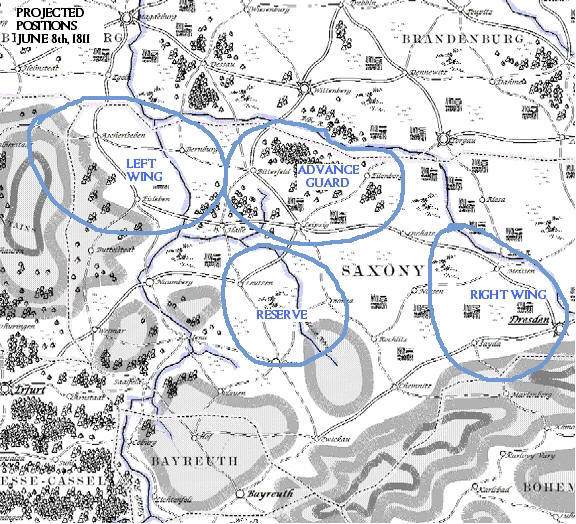 With
the destruction of the Russian army at Bayreuth, Napoleon immediately began to
plan for the next phase of the operation. There were no reports of contact with
the Austrians or Prussians, so it was determined that by pushing on Berlin, they
would force some Prussians out to fight.
With
the destruction of the Russian army at Bayreuth, Napoleon immediately began to
plan for the next phase of the operation. There were no reports of contact with
the Austrians or Prussians, so it was determined that by pushing on Berlin, they
would force some Prussians out to fight.
The Battalion Carre therefore was to conduct a wheel with the Left wing advancing toward Magdeburg, the Center to take Leipzig, and the right to try to take Dresden. Primarily though, the goals here were to spread out to get maximum ability to find the enemy but to reach the Elbe and establish which crossing points could be used.
The army would need to hurry to reach its objectives by the 8th and some would fail to achieve those immediate goals.
Massena, with the Right wing, would encounter a Saxon garrison at Dresden fortress that would resist him. Davout and the left wing would quickly begin to get intelligence of a massive Prussian presence within the fortress of Magdeburg.

With the treaty of Milan, the coalition players would be able to bring another army into the German theater and Napoleon's wing would be reduced in size to where it would consist of only the Imperial Guard divisions. Although the Russians were making good gains in Italy, there was a sense that if something was not done to create a force capable of taking on the Battalion Carre, Prussia would fall within weeks. Bagration's army was moved to Breslau, Silesia.
THE BATTLE FOR SAXONY
 With
Blucher sitting in Magdeburg and Yorck in Berlin, and now a Russian army forming
in Silesia, it was felt by elements of the coalition that
the next major struggle would be the battle for Saxony. Therefore, General Yorck
drove his army by forced marches southeast and toward Dresden.
With
Blucher sitting in Magdeburg and Yorck in Berlin, and now a Russian army forming
in Silesia, it was felt by elements of the coalition that
the next major struggle would be the battle for Saxony. Therefore, General Yorck
drove his army by forced marches southeast and toward Dresden.
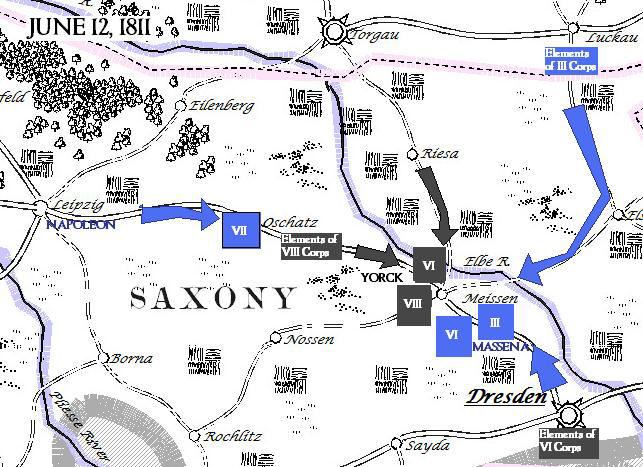 Even
as Yorck was pushing across the Elbe at Meissen, in an
attempt to reach the besieged Saxon army in Dresden, the French under Ney
crossed the Elbe at Wittenberg and found one of Yorck's corps there. Marshal
Davout was demonstrating south and east of Magdeburg, hoping to either pin
Blucher or to draw him out of the fortress and into a battle where Ney and
Davout could be combined against him. Earlier, Davout had detached VIII Corps to
swing around the Frankenwald and head for Magdeburg from the west. These troops
would capture Hanover on the 14th of June and cause alarm in Magdeburg.
Even
as Yorck was pushing across the Elbe at Meissen, in an
attempt to reach the besieged Saxon army in Dresden, the French under Ney
crossed the Elbe at Wittenberg and found one of Yorck's corps there. Marshal
Davout was demonstrating south and east of Magdeburg, hoping to either pin
Blucher or to draw him out of the fortress and into a battle where Ney and
Davout could be combined against him. Earlier, Davout had detached VIII Corps to
swing around the Frankenwald and head for Magdeburg from the west. These troops
would capture Hanover on the 14th of June and cause alarm in Magdeburg.
On the 12th of June, Massena and Yorck clashed at Meissen on the Elbe.
While this battle was going on, Napoleon with VII Corps and the Guard behind, would be fighting elements of Prussian VIII Corps ay Oschatz.
12 JUNE

Battle of Meissen
Yorck would be defeated at Meissen but the siege of Dresden would be relieved. The French would be held on the west bank of the Elbe now.
Perhaps tentatively, Blucher would lash out south of Magdeburg as Davout's VIII Corps tried to rejoin the French army. Hastily, the French gathered up five corps (including the Imperial Guard) to meet Blucher at Aschersleben but at the last minute, Blucher pulled his troops back into Magdeburg fortress.
With Yorck going southeast toward Dresden and
Blucher remaining at Magdeburg, there was a massive gap
between the armies of the coalition. The besieged Prussian Corps at Wittenberg
was the only force between Marshal Ney and Berlin. It took the French Marshal a
few days to realize that the gap was there but when he saw it, he immediately
sent a corps north. Berlin was captured by the French on the 15th of June.

Immediately following the parade of French troops through the Berlin streets, Napoleon proposed a treaty to end the war.
The loss of Berlin sent shock waves through the Prussians and their Russian allies. Yorck, having troops cut off in Dresden, a corps trapped under siege at Wittenberg, and the remaining part of its army battered from the battle of Meissen, was in no shape to rescue Berlin. Instead then he hovered near Torgau fortress and waited for Bagration's Russians to march west to them.
Blucher though could not afford to wait in
Magdeburg,
 but
with no contact from any allies, knew it to be rash to take the direct
road to Berlin through what seemed to be endless numbers of French. He therefore
marched north to get at Berlin from the northwest. This
march would remove his army from the conflict for a few weeks.
but
with no contact from any allies, knew it to be rash to take the direct
road to Berlin through what seemed to be endless numbers of French. He therefore
marched north to get at Berlin from the northwest. This
march would remove his army from the conflict for a few weeks.
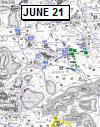 The
true motivation behind the treaty proposal and indeed the primary reason for the
French taking Berlin was to force the Prussians to fight. Napoleon did not want
them sitting forever in the fortresses of Magdeburg, Wittenberg, Torgau, and
Dresden. This was especially important with a Russian army coming in from the
east and the Austrians somewhere in the south still. Impatiently, the French
Emperor ordered his Battalion Carre to move against Yorck, seeking to break that
Prussian army while he waited for the other coalition forces to arrive. The
Russians were already arriving at Torgau though.
The
true motivation behind the treaty proposal and indeed the primary reason for the
French taking Berlin was to force the Prussians to fight. Napoleon did not want
them sitting forever in the fortresses of Magdeburg, Wittenberg, Torgau, and
Dresden. This was especially important with a Russian army coming in from the
east and the Austrians somewhere in the south still. Impatiently, the French
Emperor ordered his Battalion Carre to move against Yorck, seeking to break that
Prussian army while he waited for the other coalition forces to arrive. The
Russians were already arriving at Torgau though.
Marshals Ney and Massena were ordered to bring their armies to Torgau. The Imperial Guard would march there from Leipzig. II Corps would seek to pin Russian reinforcements from Luckau. Marshal Davout would be assigned the task of finding Blucher and keeping him out of this fight.
The combined armies of Bagration and Yorck would meet the French just east of Torgau fortress, at the village of Rehfeld.
21 JUNE

Battle of Rehfeld
THE COALITION ATTACKS
 Having
won at Torgau, Bagration and Yorck together commenced to march for the relief of
Berlin. Portions of Yorck's forces were marching on Leipzig from Meissen.
Blucher is attacking Berlin from the north. With Ney's force falling back north
from Torgau, there was a real danger that it would be caught between the
coalition forces. At the same time, Napoleon was receiving spy reports from the
south, indicating that the Austrians were in theater. If Charles was at
Bayreuth, there was a real threat to the French lines of communications.
Having
won at Torgau, Bagration and Yorck together commenced to march for the relief of
Berlin. Portions of Yorck's forces were marching on Leipzig from Meissen.
Blucher is attacking Berlin from the north. With Ney's force falling back north
from Torgau, there was a real danger that it would be caught between the
coalition forces. At the same time, Napoleon was receiving spy reports from the
south, indicating that the Austrians were in theater. If Charles was at
Bayreuth, there was a real threat to the French lines of communications.
 The
French though gambled. Rather than seeing this as a danger, it would be an
opportunity to seize the central position and use the Battalion Carre to full
effect. French forces were hurried into the plains south of Berlin.
The
French though gambled. Rather than seeing this as a danger, it would be an
opportunity to seize the central position and use the Battalion Carre to full
effect. French forces were hurried into the plains south of Berlin.
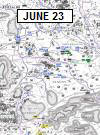 Before
they could assemble, Ney would be pursued by Yorck to Dennewitz and driven back
again, this time to Trebbin. Trebbin would be where the French would assemble,
with Napoleon exerting his Marshals to hurry their men to this juncture. From
here, across the Spree River, Prussian troops could be seen re-entering Berlin
on the 25th of June.
Before
they could assemble, Ney would be pursued by Yorck to Dennewitz and driven back
again, this time to Trebbin. Trebbin would be where the French would assemble,
with Napoleon exerting his Marshals to hurry their men to this juncture. From
here, across the Spree River, Prussian troops could be seen re-entering Berlin
on the 25th of June.
THE CENTRAL POSITION
Now was the opportunity for the French to
demonstrate the full power of the Battalion Carre and the central position. A
single corps would be sent to engage Blucher and Berlin and the rest of the
armies of Ney and Davout were hurled at
 Bagration
and Yorck. Once a clear picture was received of enemy forces, the Reserve was
sent forward to reinforce the battles that the French would choose to.
Bagration
and Yorck. Once a clear picture was received of enemy forces, the Reserve was
sent forward to reinforce the battles that the French would choose to.
The primary goal of the French was to finish off
Yorck's army and the secondary goal was to drive Bagration east, away from
Berlin. If these objectives could be achieved then the army would swiftly turn
north and hit Blucher at Berlin. From the Coalition perspective, they thought that they were set to link
up the armies of Blucher with those of Yorck and Bagration, and a massive
coalition could be achieved south of Berlin. Unfortunately though for the
allies, they were unable to get couriers through the French and so could not
coordinate that manoeuvre.
Berlin. From the Coalition perspective, they thought that they were set to link
up the armies of Blucher with those of Yorck and Bagration, and a massive
coalition could be achieved south of Berlin. Unfortunately though for the
allies, they were unable to get couriers through the French and so could not
coordinate that manoeuvre.
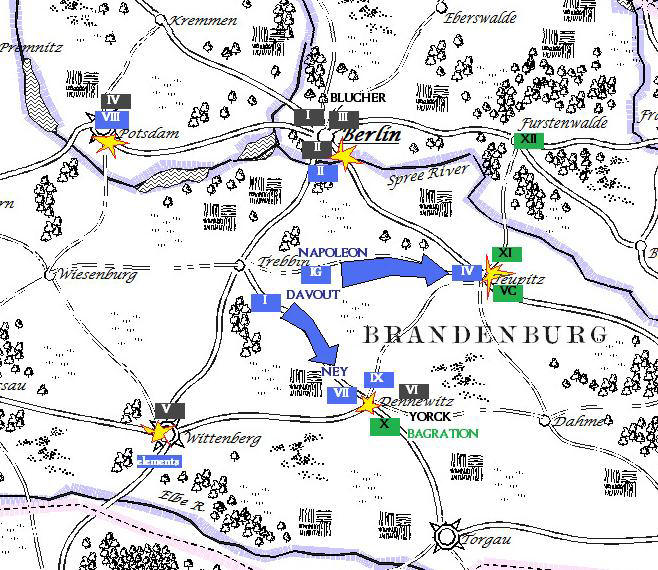
Three significant battles would be fought on the 27th of June. At Berlin, the forces of French II Corps would fight a delaying action before withdrawing back across the Spree.
At Teupitz, French IV Corps and the Imperial Guard under Napoleon and Davout would seek to drive off 69,000 Russians with 54,000 French.
The Battle of Dennewitz would see Ney with 43,000 up against Yorck and Bagration with 50,000. This is the fight that the French wanted to be most decisive.
Due to some miscommunication, the French pulled
too many troops off of the siege of Wittenberg so
 that Yorck's V Corps was free
to leave. This would result in some tense days for the French Emperor with his
communications link to Massena cut, who was still south of the Elbe watching for
Archduke Charles.
that Yorck's V Corps was free
to leave. This would result in some tense days for the French Emperor with his
communications link to Massena cut, who was still south of the Elbe watching for
Archduke Charles.
It was unknown to the French, Yorck and Blucher were fighting without a functioning depot. After their depot in Berlin had been captured, they could not begin construction of another until Berlin had been recaptured.
27 JUNE Battle of Teupitz |
27 JUNE |
27 JUNE Battle of Dennewitz |
Decisive victories would be achieved by the French at both battles. As a result of the defeat at Dennewitz, Yorck's army was all but destroyed. The Wittenberg corps that had been besieged for so long was not strong enough to leave the fortress and the Prussian general couldn't get an order through to them in any case. The 14,000 Saxons of VIII Korps were defending Dresden and could not be used to attack with.
Bagration was again frustrated by the large numbers of conscripts in his army so he would order his wing to make for Breslau to reform and retrain.
The retreat of Yorck and Bagration to the
southeast left Napoleon free to turn his army. A discussion was held with his
wing commanders. Napoleon thought that the army was needed to go south the fight
the Austrians. The Prussians at Wittenberg were preventing him from getting any
news from Massena south of the Elbe. For all they knew, the Austrians were
already at Leipzig. Davout though advocated for an attack on Berlin. It was
close and could be attacked by three wings within a couple of days. The Marshal
would persuade the Emperor.
THE BATTLE OF BERLIN
French IX Corps would go to resume the siege of
Wittenberg and open up the line of communications with Massena. The rest of the
army would use every available road to mass on Berlin for a battle on June 30th.
French VII Corps, unable to find a direct road to Berlin from Teupitz, tried to
get there via Furstenwalde and ran up against Bagration's small XII Corps.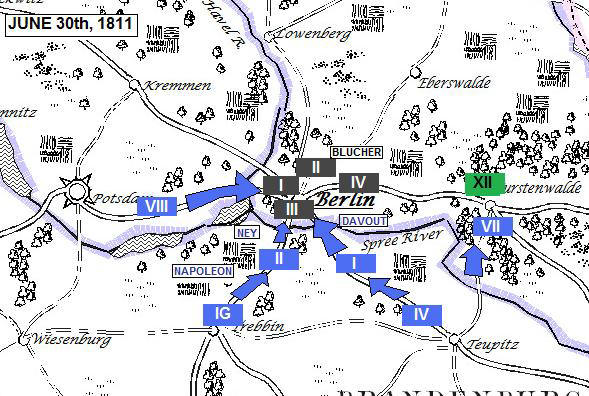
The French would approach Berlin by three roads with forces arriving at the battlefield throughout the day. It would be an epic clash between 92,000 French and 85,000 Prussians. Blucher had heard the reports from the defeats ay Teupitz and Dennewitz. He knew that the Battle of Berlin would be of critical importance. If his army was destroyed, then there would be no army north of the Elbe to contest Germany. Therefore, he adopted an entirely defensive position at Berlin, played it cautious, and fought for survival of Prussia as a major force in Europe.
For the French it was also a crucial time. Their line of communications was stretched and the Austrians might have already broken it. Napoleon knew that his army was nearly exhausted but that the momentum had to be maintained to leave the coalition allies afraid.
30 JUNE

Battle of Berlin
SURRENDERING THE INITIATIVE
The Emperor ordered a retreat from Berlin, and the movement was executed cleanly. The whole of the French army was united south of the Spree River, with Massena's wing remaining south of the Elbe. Another attempt on Berlin was out of the question. The position was too strong and the French army too worn out. Orders were issued to fall back on the Elbe. Ney was to maintain the siege of Wittenberg while gathering replacements. The priority for the army was to get south to deal with the Austrians, get replacements, and avoid getting surprised by the Russians and Prussians if they went on to the offensive.
While at Wittenberg, despite having suffered a defeat at Berlin, Napoleon proposed a peace treaty to the coalition leaders. This treaty would still result in some serious concessions to the French, but it was not as decisive a treaty as the French would have wished. The intention of the French Emperor was to use the threatened deadline of this treaty to encourage the coalition to go on the offensive before it was ready and reorganized. If all four allied wings could coordinate an attack on the French, even after they were reinforced, it would spell doom for the French. Hopefully, the coalition would continue to attack disjointed.
But they did not attack. Blucher, having survived an assault on Berlin, was not going to abandon it to throw the victory away. Bagration still needed to rebuild and was continuing east. Yorck was attacking, on his own, but the only thing that he achieved was to get the last of his army trapped inside the siege at Wittenberg. Tragically, the wing of Yorck was reduced to 25,000 men inside that fortress. On July 3rd, 67,000 French passed Wittenberg on their way south.
LEIPZIG

But also on July 3rd, couriers from Marshal Massena arrived at Imperial Headquarters. The Austrians had begun moving aggressively north. They had encountered French VI Corps at Leutzen and General Moreau, commanding there, was unwilling to make a stand.
He retreated to Leipzig and Massena brought in the whole of his wing to fight the battle there. Archduke Charles would concentrate all of the Austrians there by multiple roads with his grenadiers being obliged to come from the west.
Hearing about the gathering conflict at Leipzig, Napoleon sent out orders to Davout and Ney to move all available forces to that city. It would turn out that this was sloppy ordering that would cost some forces at the coming battle as eleven divisions would try crossing the Elbe bridges, creating a congestion that would prevent troops from reaching the fight.
4 JULY

Battle of Leipzig
The Austrian defeat at Leipzig was shattering for
Archduke Charles. It left his army retreating south, with no chance for any support from his coalition allies. The French were free to
pursue. Furthermore, word reached Charles that the
Austrian forces of Weyrother that were fighting in the Alps had been
outmanoeuvred by the French once more and were in full retreat back toward
Salzburg. All that the Austrians in Saxony could do was retreat into Bohemia and
hunker down. Archduke Charles therefore negotiated a peace with the French, to
the effect where Austria would remove themselves from the coalition against
France.
no chance for any support from his coalition allies. The French were free to
pursue. Furthermore, word reached Charles that the
Austrian forces of Weyrother that were fighting in the Alps had been
outmanoeuvred by the French once more and were in full retreat back toward
Salzburg. All that the Austrians in Saxony could do was retreat into Bohemia and
hunker down. Archduke Charles therefore negotiated a peace with the French, to
the effect where Austria would remove themselves from the coalition against
France.

Archduke Charles' player opted to remove the Austrian army and start to raise a fresh force of British in Stettin.
THE COALITION ADVANCES
There began then a period where both opposing armies could take the time to rebuild. The French were getting their replacements from Mainz, which was 11 days march from Leipzig. The Russians were waiting three days east of Breslau to rebuild. The Prussian replacements came from Posen, which was six days east of Berlin. The newly arrived British Expeditionary Force, landed at Stettin, had to complete its muster then march the five days south to Berlin.
Bagration began to move west again on the 9th so that on the 11th of July, his leading elements were able to find French VII Corps at Lubben. Bernadotte's corps had been left on its own without orders since its engagement at Furstenwalde while the battle of Berlin took place. At Lubben, Bernadotte was able to hold his ground until nightfall but he withdrew when he had the benefit of darkness. While reports were reaching Ney from Bernadotte in the east, piquets north of Wittenberg were reporting that Blucher had crossed the Spree and was advancing south.
The French meanwhile we preparing to launch an
offensive of their own. Initial orders from the Emperor were to have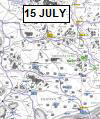 the advance begin on the 10th but his marshals insisted that they would not be
in position before the 15th. Ney was now ordering his corps to fall back south
of the Elbe. Davout was gathering at Torgau and Massena was massing at Dresden.
The French plan of attack was to be east down the Torgau-Cottbus highway to try
to hit the Russians while Ney would defend the Elbe against Blucher.
the advance begin on the 10th but his marshals insisted that they would not be
in position before the 15th. Ney was now ordering his corps to fall back south
of the Elbe. Davout was gathering at Torgau and Massena was massing at Dresden.
The French plan of attack was to be east down the Torgau-Cottbus highway to try
to hit the Russians while Ney would defend the Elbe against Blucher.
PEACE
But July 15th would arrive and the leaders of the
coalition would agree to the terms of the treaty of Wittenberg. Peace was
declared in Germany.

The political result of the treaty would mean that the Confederation of the Rhine would gain Hesse-Cassel as a province and both Berg and Ansbach would become minor French allies. Prussia would hold on to Westphalia and Bayreuth among the German states. Hanover would leave the Coalition. From the Treaty of Leipzig, the French returned Salzburg to neutrality. No changes were achieved by either side in Italy.
*******
Near the start of the war, the total French forces numbered some 367, 000 infantry and 60,500 cavalry. The coalition fielded 404,500 and 73,000 cavalry.
Shortly after the treaty of Milan, The Battalion Carre in Saxony has 264,500 Frenchmen. Surrounding them were 462,000 Prussians, Russians, and Austrians.
At the time of the Battle of Leipzig, French had 203,500 infantry, 25,500 cavalry in Germany. The coalition fielded 282,000 infantry, 40,500 cavalry
When the War of the Sixth Coalition ended, it looked something like this:
French: 226,500 infantry, 34,000 cavalry
Allies: 320,000 infantry, 47,000 cavalry
The French army had been reduced by some 40%. The allies had been reduced by
25%.
,